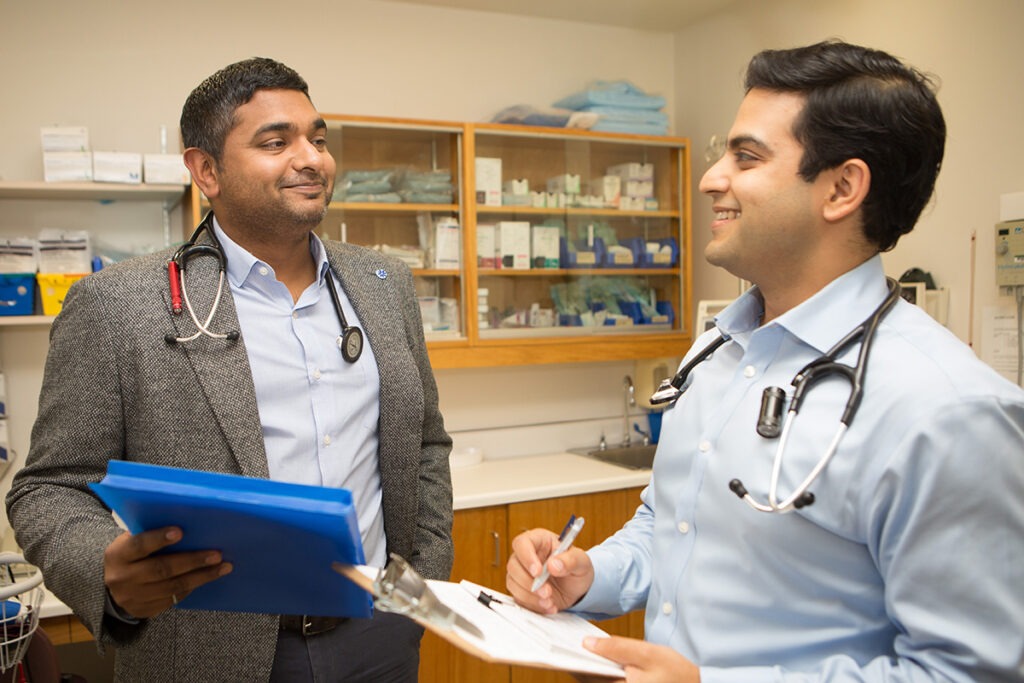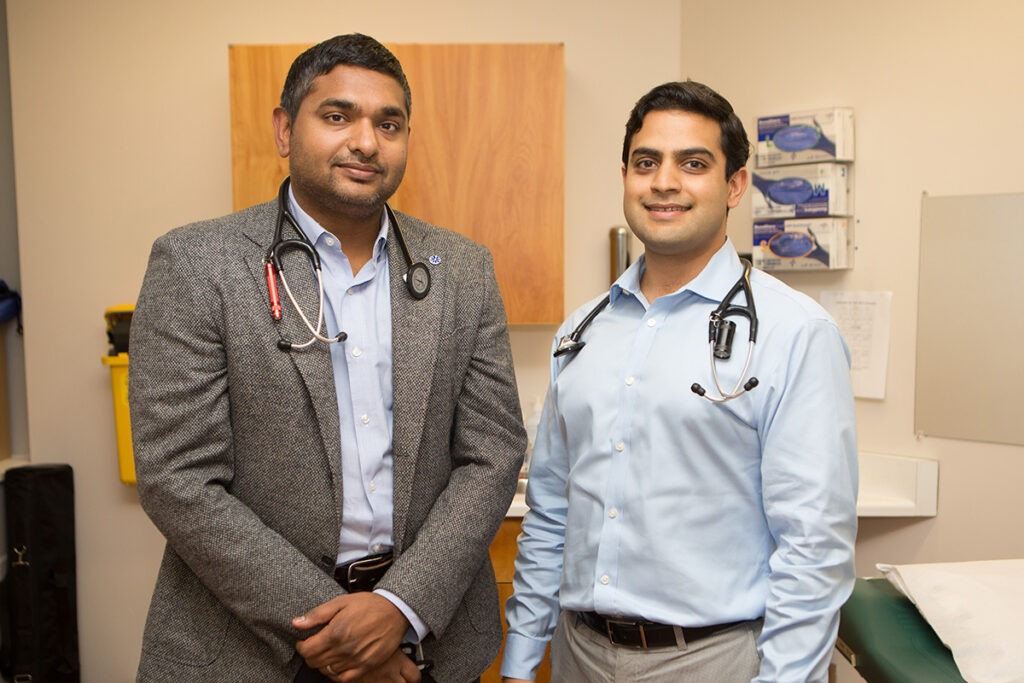Can patient data improve hospital care? The physician-researchers behind GEMINI set out to find out

Dr. Fahad Razak and Dr. Amol Verma are pictured here at St. Michael's Hospital. Please note this photo was taken before the COVID-19 pandemic.
Every test, vital sign measurement and medication prescribed is a data point on a patient’s care journey in the hospital. But how can we use that data to measure and improve the quality of patient care within and across different institutions, when hospitals don’t use the same data systems to generate and store information?
More than seven years ago, two General Internal Medicine physicians and researchers at St. Michael’s Hospital, Dr. Fahad Razak and Dr. Amol Verma, set out to answer this question and bridge the gaps that exist in hospital data collection. They wanted to understand the care provided on medical wards and use data to improve it.

Their goals set into motion GEMINI, a program that collects, formats, standardizes and analyzes clinical data from hospitals to improve how health care is delivered. Since its inception, GEMINI has grown from a pilot project anchored at Unity Health Toronto and just a few other Toronto area hospitals to the largest network of its kind in Canada, covering 33 hospitals and 60 percent of the province.
During the pandemic, GEMINI continued to lead the way in hospital data collection and analysis, helping quickly bring to light information about Canadian hospital care that no one else in the country had access to. We spoke to the Dr. Razak, who is also the new Scientific Director for the Ontario COVID-19 Science Advisory Table, to learn about GEMINI’s recent work and what’s on the horizon.
How has GEMINI progressed since its inception?
The main barrier we faced when we started this program was that the huge trove of data that’s generated as part of clinical care was not available to be used to understand the kind of care that we’re providing. The lab tests we order, the medications we prescribe, the vital signs that are measured are all data points that are collected, but where in the hospital are they, and how do you get access to them and extract them?
The core mission of GEMINI was to get all of that information out of complex hospital systems, and to bring it into a central dataset that can be used for analysis for reporting for quality improvement.
In Canada and Ontario, there is no single way that data is stored in hospitals or across hospitals and so every hospital has its own complex backend to store information. Imagine decades upon decades of layered on systems with often incomplete documentation. It has taken a lot of elbow grease to figure out how to transfer data from more than 1 million patient admissions (and counting) containing billions of data points worth of information out and ensure their accuracy. We have accuracy from 97 to 100 per cent now which means this data is ready to use to improve quality of care and for research.
How have the last two years enhanced GEMINI’s purpose?
The evidence we saw from other parts of the world early in the pandemic was that hospitals were one of the highest risk parts of the health system for collapse – places like Italy and New York City come to mind. The question we focused on was what can we do to understand our hospital care capacity and how can we help address similar collapse from occurring here? In Canada, there was no single dataset to look at the hospitals – until GEMINI. With the enhanced concern about hospitals being vulnerable, GEMINI’s role became more important.
A lot of pivotal papers about the Canadian response to the pandemic were produced by GEMINI and that was a really important opportunity for us to use our data rapidly and demonstrate to hospitals why rapid data turnaround was important.
For example, the first and largest study of patients hospitalized with COVID in Canada was a GEMINI paper. The first paper in Canada to look at hospitalized patients with disabilities was also GEMINI-led. As was the first paper to look at Canadian shortages in one of the few life sustaining therapies for COVID-19 Tocilizumab, which also proposed an ethical allocation framework.
Quality improvement is one of the pillars of GEMINI’s work. How does the data collection and analysis lead to improvements in care?
GEMINI has worked towards a learning health system, which is the idea that there is a continuous circle of feedback that happens between those who are providing care, the data that’s generated as part of providing care and researchers and quality improvement experts who are very quickly analyzing and feeding the information back to the providers so that you get this circle of improvement happening.
It’s about having insight on everything that we do. Prior to GEMINI, if you were a physician who worked in hospitals, there was a reasonable chance that in your entire career you may have never received any data about the care you provide. This is a very complex environment that we practice in. We can’t expect anyone to improve what they’re doing without having any information about it. A circle of improvement is impossible without data.
How does Artificial Intelligence (AI) integrate with the work that GEMINI does?
We have really started to move the needle with patient safety. Some of the most important things that happen with patient safety in hospital are things that are preventable or addressable if you were able to identify them, and identify where they’re occurring more frequently.
One example is blood clots: Patients in hospital have a higher risk of clots because when they’re sick and in bed, as the blood is not circulating as much and is more inflamed in some ways. A blood clot in the leg (a deep vein thrombosis) can break off and move to the lungs – causing a life threatening pulmonary embolism. This is an important patient safety event we can prevent but we have very little information about the frequency that it occurs in hospital. GEMINI developed an algorithm that reads the text of radiology reports for patients across the province to identify when these clots occur and we can now see where and when there are higher rates of clotting and physicians can intervene.
What are some of challenges that exist in the space GEMINI occupies?
One challenge is cultural: There aren’t a lot of incentives for hospitals to share resources or data with one another. Before GEMINI there wasn’t any example in the country of large network of hospitals coming together to share such enormous data repositories – that requires a lot of trust.
It wasn’t a coincidence that Unity Health took the lead on this as the site to do it. We are known to be a team player as an institution. We are known to be world class with our data and analytics. We recognized as a group that we would not try to make all of the leadership and value add anchored to Unity because we wanted people to share this across the system. This is a win for the people of Ontario. That’s been critical to our growth because if hospitals try and compete with each other, there’s never going to be an incentive for them to share. We’ve demonstrated that by sharing we can collectively do more.
How does equity and inclusion play a role in the work GEMINI is doing?
We want to demonstrate that even though electronic data has some limitations, we can take the existing information we have, and still show important gradients across equity parameters, whether it’s the neighborhood you live in, whether it’s your age, whether it’s disability status. We’re trying to use every advanced analytic method we have to pull out as much as we can around the equity characteristics and demographic characteristics of patients.
We also think we’re an important group to demonstrate that even at the very cutting edge of what you can do with electronic data, there’s certain things you cannot recreate without directly asking people. You cannot understand their home situation, whether they have trouble getting groceries, whether they’re on the verge of being evicted.
We want to show you can do a lot, but we also want to show where the real gaps are to help make the case that we should gather this information systematically for patients because it’s important to health.
What are some exciting areas of work on the horizon?
A major thrust is going to be helping physicians to understand how to use this information, make concrete targets for improving quality of care and then helping them track over time whether they achieve those targets by using GEMINI data.
These kinds of deep clinical holdings are valuable in delivering improved patient care. We have a major partnership with the Vector Institute and a lot of our work over the next few years will be taking the best AI scientists in the world, giving them access to GEMINI and seeing what they can predict, analyze and provide for hospitals.
GEMINI has also become one of the most widely used data sets for students to learn how to analyze health data. In the next few years, we will become probably one of the largest groups in the country supporting the next generation of scientists and clinicians to understand the role of health data and learn how to use it.
What would you like people to know about the work you do?
We are we are holders of deeply sensitive information about patients. That information can be used with the highest standards of privacy protection to improve the care of individuals, and to ensure the sustainability of our health system.
This is a partnership with the public and with the health system to use individuals’ data — which is deeply sacred — to help improve their care but also in a shared way to improve the system. We want people to understand that that can be done in a very safe way and that all of us in Ontario and people in Canada can benefit greatly from it.
